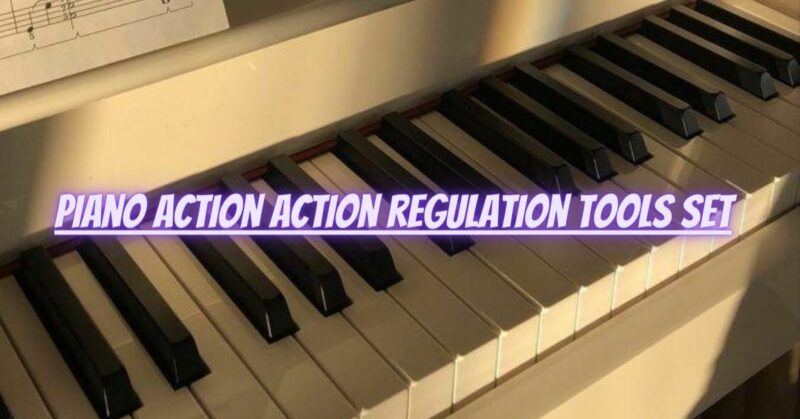A piano action regulation tools set is a collection of specialized tools that are used by professional piano technicians to perform precise adjustments and maintenance on a piano’s action mechanism. These tools are essential for regulating the touch, responsiveness, and overall performance of the piano’s keys, hammers, and related components. Let’s explore some of the essential tools found in a typical piano action regulation tools set:
1. Key Leveling Tools: Key leveling tools are used to check and adjust the height and alignment of the piano keys. These tools ensure that the keys are at the same level and do not wobble, providing a consistent touch across the keyboard.
2. Hammer Voicing Tools: Hammer voicing tools include various needles and shaping tools used to shape and soften the hammer felt. Voicing helps achieve an even and desirable tone from each hammer, enhancing the piano’s overall sound quality.
3. Regulating Screwdrivers: Regulating screwdrivers come in various sizes and are used to adjust the piano action’s regulating screws. These screws control the key’s various aspects, such as the aftertouch, let-off, and drop, affecting the key’s responsiveness.
4. Hammer Butt Flange Felt Tools: Hammer butt flange felt tools are used to replace and adjust the felt strips between the hammer butt flange and the action rail. These adjustments impact the distance of the hammers from the strings, affecting the piano’s touch.
5. Whippen Regulating Punchings: Whippen regulating punchings are used to regulate the distance between the whippen and the backcheck. Proper regulation ensures precise repetition and the quick return of the hammers after being released.
6. Capstan Regulating Tools: Capstan regulating tools are used to adjust the capstan screws that control the key’s upstop and letoff buttons. These adjustments impact the distance the hammer travels before being released.
7. Key Frame Leveling Gauges: Key frame leveling gauges are used to ensure the piano keys are aligned horizontally and vertically. Proper key frame leveling ensures smooth and even key movement.
8. Key Bushing Reamers: Key bushing reamers are used to create precise holes for key bushings. Replacing worn or damaged key bushings helps reduce key wobble and ensures stable key movement.
9. Regulating Felt Strips: Regulating felt strips are used to replace worn or compressed felt parts within the piano action mechanism. These strips play a crucial role in achieving a well-regulated action.
10. Hammer Rail Punchings: Hammer rail punchings are used to regulate the distance between the hammer and the strings when the key is pressed. Properly regulated hammer rail punchings impact the piano’s touch and key response.
11. Backcheck Regulating Tools: Backcheck regulating tools are used to adjust the distance and timing of the backchecks. Proper backcheck regulation ensures the hammers do not bounce back excessively after striking the strings.
Piano action regulation is a precise and intricate process that requires the use of specialized tools to achieve optimal performance. While some tools are more common and found in most regulation sets, professional piano technicians may also have additional custom-made or specialty tools to address specific piano models and action types. It’s important to entrust piano action regulation to qualified technicians with expertise in using these tools to ensure the piano’s action is regulated to its highest potential. Proper action regulation ensures the piano’s responsiveness, touch, and tone are at their best, allowing pianists to express themselves freely and enjoy an exceptional playing experience.


